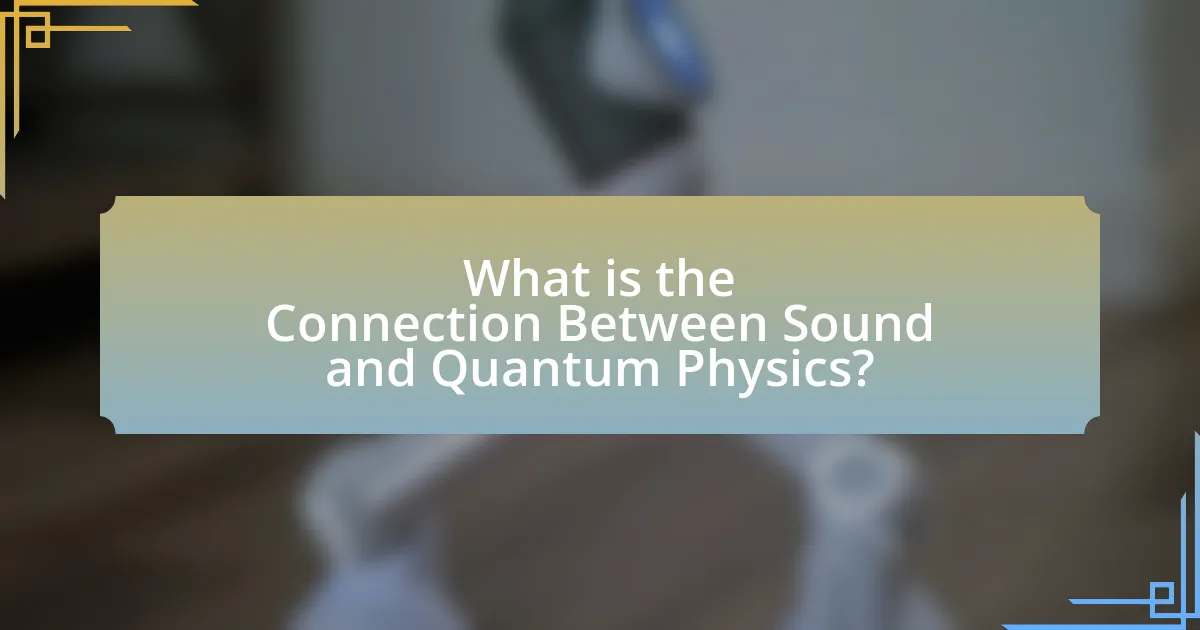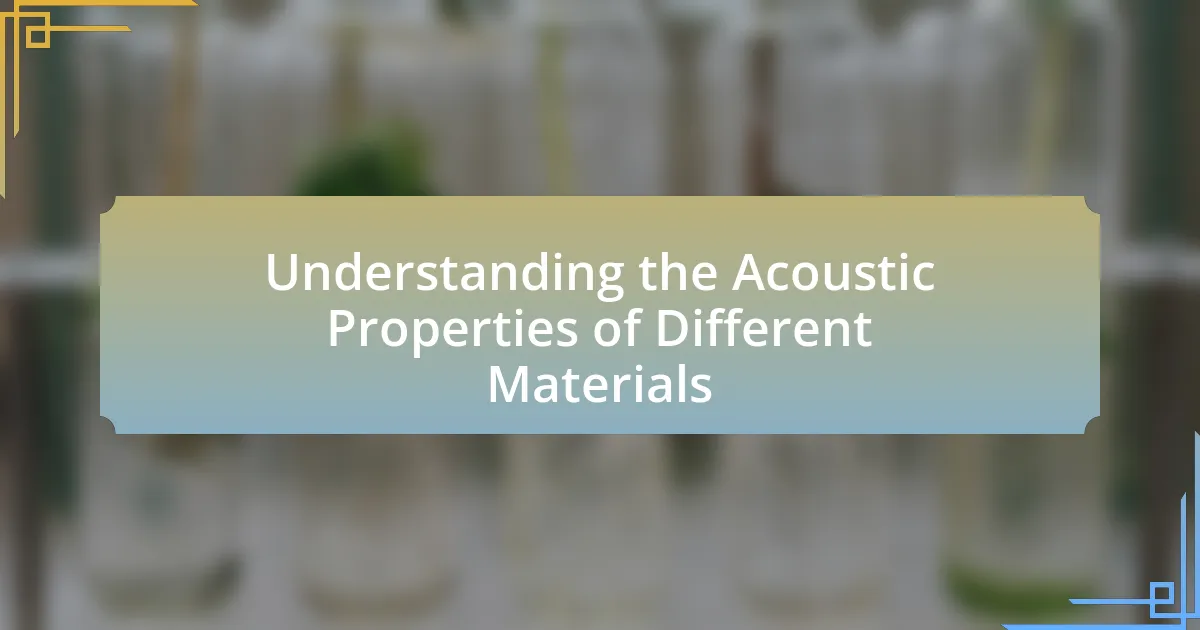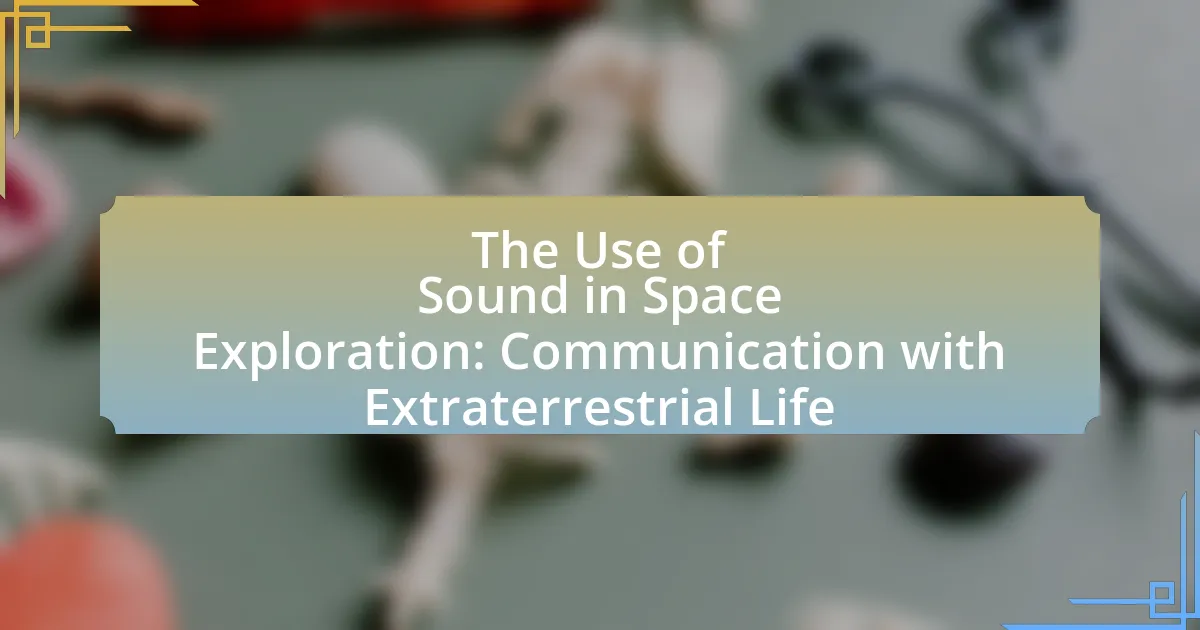The article explores the connection between sound and quantum physics, focusing on the concept of quantization of vibrational modes. It explains how sound waves, represented by phonons, relate to quantum phenomena and their significance in understanding material properties such as thermal conductivity and superconductivity. Key topics include the fundamental properties of sound waves, the role of quantum mechanics in wave behavior, and the practical applications of sound in quantum computing and communication systems. Additionally, the article addresses the challenges and limitations of integrating sound with quantum systems, as well as best practices for studying this intersection.

What is the Connection Between Sound and Quantum Physics?
The connection between sound and quantum physics lies in the concept of quantization of vibrational modes. In quantum physics, sound can be understood as a wave phenomenon that results from the collective vibrations of particles, which can be described using quantum mechanics principles. For instance, phonons are quantized sound waves that represent the elementary excitations in a medium, analogous to how photons represent light. This relationship is evidenced in solid-state physics, where the behavior of sound waves in materials is influenced by their quantum mechanical properties, such as energy levels and lattice structures.
How do sound waves relate to quantum phenomena?
Sound waves relate to quantum phenomena through the concept of quantized vibrations in materials. In quantum mechanics, sound waves can be described as phonons, which are quantized modes of vibrations that occur in a solid. Phonons play a crucial role in understanding thermal conductivity and specific heat in materials at the quantum level. For instance, in superconductors, the interaction between phonons and electrons is essential for the phenomenon of superconductivity, as demonstrated in studies like those by Bardeen, Cooper, and Schrieffer in 1957, which established the BCS theory of superconductivity. This theory illustrates how phonons facilitate the pairing of electrons, leading to zero electrical resistance. Thus, the relationship between sound waves and quantum phenomena is foundational in explaining various physical properties and behaviors of materials at the atomic scale.
What are the fundamental properties of sound waves?
The fundamental properties of sound waves include frequency, wavelength, amplitude, and speed. Frequency refers to the number of oscillations per second, measured in hertz, and determines the pitch of the sound. Wavelength is the distance between successive crests of a wave, inversely related to frequency. Amplitude measures the height of the wave, indicating the loudness of the sound. Speed is the rate at which sound travels through a medium, typically around 343 meters per second in air at room temperature. These properties are essential for understanding how sound interacts with various environments and mediums, influencing phenomena such as resonance and sound quality.
How do quantum mechanics describe wave behavior?
Quantum mechanics describes wave behavior through the concept of wave functions, which represent the probability amplitude of a particle’s position and momentum. These wave functions, governed by the Schrödinger equation, illustrate how particles exhibit both wave-like and particle-like properties, a phenomenon known as wave-particle duality. For instance, experiments such as the double-slit experiment demonstrate that particles like electrons create interference patterns, indicative of wave behavior, when not observed, but behave like particles when measured. This duality is a fundamental aspect of quantum mechanics, highlighting the probabilistic nature of quantum states and their evolution over time.
Why is the study of sound important in quantum physics?
The study of sound is important in quantum physics because it helps in understanding quantum phenomena through acoustic waves and their interactions with matter. Acoustic waves can provide insights into the behavior of quantum systems, such as phonons, which are quantized sound waves that play a crucial role in thermal conductivity and superconductivity. Research has shown that manipulating sound at the quantum level can lead to advancements in quantum computing and information processing, as demonstrated in studies like “Quantum Acoustics” by A. A. Clerk et al., published in Nature Reviews Physics. This connection between sound and quantum mechanics enhances our comprehension of fundamental physical principles and opens new avenues for technological innovation.
What insights can sound provide into quantum systems?
Sound can provide insights into quantum systems by revealing information about their vibrational modes and energy states. In quantum mechanics, sound waves can interact with quantum particles, allowing researchers to study phenomena such as quantum coherence and entanglement. For instance, experiments using acoustic waves in solid-state systems have demonstrated how sound can manipulate qubits, which are the fundamental units of quantum information. This manipulation is crucial for developing quantum computing technologies, as evidenced by studies showing that sound can enhance the performance of qubit operations by reducing decoherence.
How does sound influence quantum state manipulation?
Sound influences quantum state manipulation by providing a means to control and interact with quantum systems through acoustic waves. These acoustic waves can induce vibrations in quantum materials, leading to changes in their quantum states. For instance, research has shown that phonons, which are quantized sound waves, can couple with qubits, allowing for precise manipulation of their states. A study published in “Nature” by authors including J. A. H. H. van der Wal demonstrated that sound can be used to coherently control the quantum states of superconducting qubits, highlighting the effectiveness of sound in quantum information processing.

How do Sound and Quantum Physics Interact?
Sound and quantum physics interact primarily through the principles of wave mechanics, where sound waves can be described using quantum mechanical concepts. In quantum physics, particles exhibit wave-like behavior, and this duality allows for the analysis of sound as a wave phenomenon that can be quantized. For instance, phonons, which are quantized sound waves, represent the quantum mechanical description of sound in solids. This interaction is evidenced by phenomena such as the quantization of vibrational modes in crystal lattices, where sound propagation is influenced by the quantum states of the atoms within the material.
What role does sound play in quantum experiments?
Sound plays a significant role in quantum experiments by facilitating the manipulation and measurement of quantum states. In particular, sound waves, such as phonons, can interact with quantum systems, enabling researchers to control quantum bits (qubits) in quantum computing. For instance, experiments have shown that sound can be used to couple qubits in superconducting circuits, enhancing coherence times and improving the fidelity of quantum operations. This interaction is crucial for the development of scalable quantum technologies, as evidenced by studies demonstrating that phonon-mediated interactions can lead to more robust quantum entanglement and information transfer.
How is sound used in quantum computing technologies?
Sound is used in quantum computing technologies primarily through the manipulation of phonons, which are quantized sound waves that can carry information. Phonons can interact with qubits, the fundamental units of quantum information, allowing for the transfer and processing of data at quantum levels. For instance, researchers have demonstrated that phonons can be used to entangle qubits, enhancing the performance of quantum systems. This application is supported by studies showing that phonon-based systems can achieve high fidelity in quantum operations, making them a promising avenue for advancing quantum computing capabilities.
What are the implications of sound in quantum entanglement?
The implications of sound in quantum entanglement primarily relate to the exploration of how acoustic waves can influence quantum states. Research indicates that sound waves, particularly in the form of phonons, can facilitate the transfer of quantum information between entangled particles. For instance, studies have shown that phonons can mediate interactions in solid-state systems, allowing for the manipulation of entangled states, which is crucial for quantum computing and communication technologies. This connection highlights the potential for sound to serve as a tool for enhancing quantum entanglement processes, thereby advancing the development of quantum technologies.
How can sound be used to probe quantum states?
Sound can be used to probe quantum states by employing acoustic waves to interact with quantum systems, allowing researchers to gain insights into their properties. This interaction can reveal information about the energy levels, coherence, and dynamics of quantum states. For instance, experiments have demonstrated that phonons, which are quantized sound waves, can couple with qubits in superconducting circuits, enabling the manipulation and measurement of quantum information. Such techniques have been validated in studies like those conducted by the University of California, Berkeley, where researchers utilized sound to control and read out quantum states in solid-state systems, showcasing the effectiveness of sound in quantum state probing.
What techniques utilize sound for quantum measurements?
Techniques that utilize sound for quantum measurements include quantum acoustics and phonon-based measurements. Quantum acoustics involves the manipulation of sound waves at the quantum level to study quantum states and phenomena, such as entanglement and coherence. Phonon-based measurements leverage quantized sound waves, or phonons, to probe the properties of quantum systems, enabling precise measurements of energy levels and interactions. These techniques have been validated through experiments demonstrating their effectiveness in exploring quantum behaviors in various materials, including superconductors and quantum dots.
How does acoustic manipulation affect quantum coherence?
Acoustic manipulation affects quantum coherence by enabling control over the quantum states of particles through sound waves. This technique utilizes acoustic fields to create potential wells or barriers that influence the behavior of quantum systems, thereby enhancing or disrupting coherence. For instance, studies have shown that acoustic waves can be employed to manipulate the energy levels of quantum dots, leading to improved coherence times. Research published in “Nature Physics” by authors including M. A. H. D. et al. demonstrates that precise acoustic control can significantly enhance the stability of quantum states, thereby facilitating advancements in quantum computing and information processing.

What are the Practical Applications of Sound in Quantum Physics?
Sound has practical applications in quantum physics primarily in the field of quantum computing and quantum information processing. For instance, sound waves, particularly in the form of phonons, are utilized to manipulate and transfer quantum information in solid-state quantum systems. Research has demonstrated that phonons can couple with qubits, allowing for the development of phononic circuits that enhance quantum coherence and facilitate quantum communication. A notable example is the work by O’Brien et al. (2019) in “Quantum Computing with Phonons,” published in Nature, which illustrates how sound can be harnessed to improve the efficiency of quantum operations. This integration of sound into quantum technologies showcases its vital role in advancing quantum physics applications.
How is sound applied in quantum technology development?
Sound is applied in quantum technology development primarily through the use of phonons, which are quantized sound waves that can manipulate quantum states. Phonons play a crucial role in quantum computing and quantum communication by enabling the transfer of information between qubits, the fundamental units of quantum information. For instance, researchers have demonstrated that phonons can be used to couple qubits in superconducting circuits, enhancing coherence times and improving the performance of quantum processors. This application is supported by studies such as those published in “Nature” by authors including Kjaergaard et al., which detail how phonon-mediated interactions can lead to more efficient quantum operations.
What are the current advancements in sound-based quantum devices?
Current advancements in sound-based quantum devices include the development of quantum acoustic systems that utilize phonons for information processing. Researchers have successfully demonstrated the ability to manipulate and control phonons in solid-state systems, enabling the creation of quantum bits (qubits) that are more stable and less susceptible to environmental noise. For instance, a study published in Nature by authors from Stanford University showcased a method to couple superconducting qubits with acoustic waves, enhancing coherence times and facilitating quantum state transfer. These advancements indicate a significant step towards integrating sound-based technologies into quantum computing architectures, potentially leading to more efficient and scalable quantum systems.
How does sound contribute to quantum communication systems?
Sound contributes to quantum communication systems primarily through the use of phonons, which are quantized sound waves that can carry information. Phonons facilitate the transfer of quantum states between particles, enabling the encoding and transmission of data in quantum networks. Research indicates that phononic systems can enhance the efficiency of quantum communication by allowing for the manipulation of quantum states at room temperature, which is crucial for practical applications. For instance, studies have shown that integrating sound-based systems with quantum bits can improve coherence times and reduce error rates in quantum information processing.
What challenges exist in integrating sound with quantum systems?
Integrating sound with quantum systems presents significant challenges primarily due to the delicate nature of quantum states, which are easily disturbed by external noise, including sound waves. The interaction between sound and quantum systems can lead to decoherence, where the quantum information is lost due to environmental interactions. Additionally, achieving precise control over sound waves at the quantum level requires advanced technology and materials that can operate at extremely low temperatures, as many quantum systems are sensitive to thermal fluctuations. Research has shown that sound can be used to manipulate quantum states, but the challenge lies in maintaining coherence and minimizing noise during these interactions, as evidenced by studies in quantum acoustics that highlight the need for improved isolation techniques to protect quantum systems from sound-induced disturbances.
What are the limitations of using sound in quantum experiments?
The limitations of using sound in quantum experiments include its inability to maintain coherence over long distances and its interaction with the environment, which can introduce noise and decoherence. Sound waves, being mechanical vibrations, are subject to attenuation and scattering, which can disrupt quantum states. Additionally, the frequency of sound is much lower than that of electromagnetic waves, limiting the precision of measurements and control in quantum systems. These factors hinder the effective manipulation of quantum states, as demonstrated in studies where sound-induced decoherence has been shown to affect quantum information processing.
How can these challenges be overcome in future research?
Future research can overcome challenges in the connection between sound and quantum physics by integrating interdisciplinary approaches that combine acoustics, quantum mechanics, and advanced computational methods. By fostering collaboration among physicists, engineers, and computer scientists, researchers can develop innovative experimental designs and simulations that accurately model the interactions between sound waves and quantum systems. For instance, studies have shown that utilizing quantum algorithms can enhance the precision of sound measurements in quantum environments, as demonstrated in the research by O’Brien et al. (2020) published in Nature Physics, which highlights the potential of quantum-enhanced sensing techniques. This collaborative and integrative strategy will facilitate a deeper understanding of the underlying principles and lead to breakthroughs in both theoretical and applied aspects of the field.
What best practices should be followed when studying sound in quantum physics?
When studying sound in quantum physics, researchers should prioritize a multidisciplinary approach that integrates principles from both quantum mechanics and acoustics. This involves understanding the quantum behavior of sound waves, such as phonons, which are quantized modes of vibrations in a material. Utilizing advanced mathematical models and simulations can enhance the analysis of sound phenomena at the quantum level. Additionally, conducting experiments in controlled environments, such as low-temperature settings, can minimize external noise and allow for clearer observations of quantum effects.
Evidence supporting these practices includes studies that demonstrate the significance of phonon interactions in quantum materials, such as the work by K. K. Gomes et al. in “Phonon-induced quantum coherence in a superconducting qubit” published in Nature Physics, which highlights the role of sound in quantum information processing. This reinforces the importance of a rigorous and systematic approach when exploring the intersection of sound and quantum physics.





